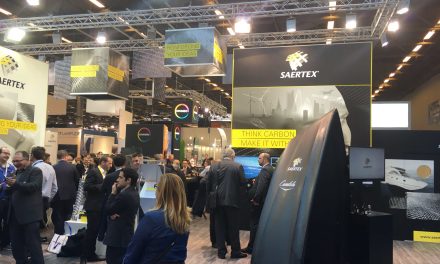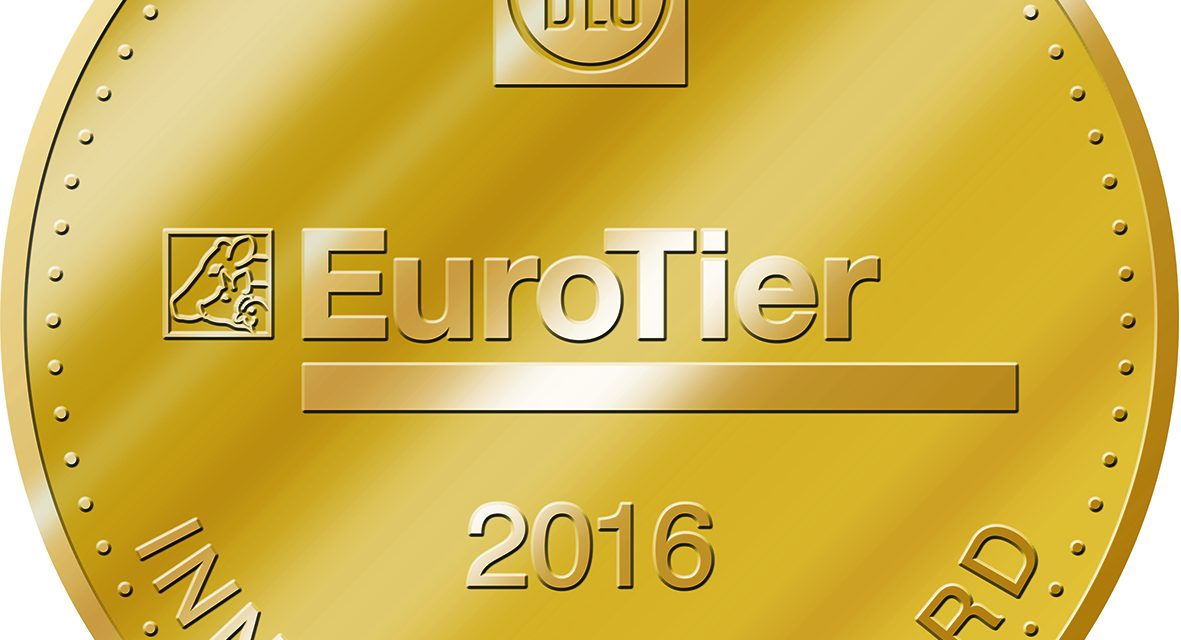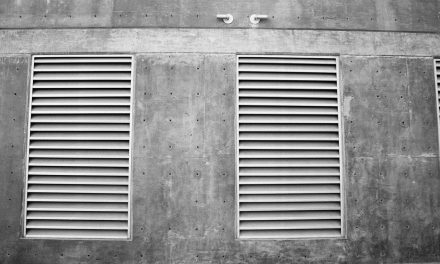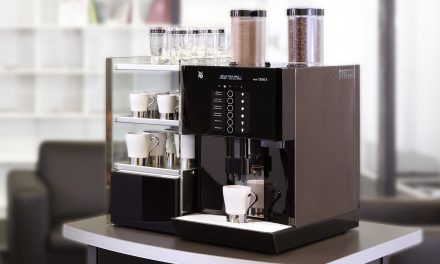Hanover, Germany, November 14, 2016 – During the world’s leading trade fair for animal production, EuroTier 2016, the DLG (German Agricultural Society) announced the winners of the Innovation Award EuroTier 2016: Four innovations were awarded a gold medal and 21 innovations received a silver medal. DLG president Carl-Albrecht Bartmer presented the medals along with the Parliamentary State Secretary at the Federal Ministry of Food and Agriculture, Dr. Maria Flachsbarth, at the formal opening of the event at Hanover on 14 November 2016.
The winners of the Innovation Award EuroTier 2016 in gold are:
- Smart Calf System
Förster-Technik, Engen, Germany, Hall 13, Stand E21
Changes in drinking patterns and reduced fluid intake are usually the first signs of disease in calves and often occur before any other visually identifiable symptoms develop. However, it is generally difficult to detect changes in behaviour and reduced volumes of fluid intake, especially on larger farms or with changing staff. Also, trying to locate a particular calf in a large area constitutes an additional challenge. The Smart Calf System by Förster-Technik delivers a comprehensive range of modules for monitoring calves both continuously throughout the day and directly as they take in milk feeds or water. The system also supports the electronic location of calves. The Smart Calf System comprises the modules Smart Drink Station, Smart Neckband and Smart Water Station. It collects important data for monitoring calf health directly from animals, including data on activity and butting behaviour on the teat. As a first, the system incorporates a workflow module with LED display on the Smart Neckband, which facilitates the quick location of animals for monitoring. Actions performed on calves can then be confirmed via a sturdy feedback switch directly on the Smart Neckband and fed back to the higher-level management system. This delivers substantial improvements of the overall system. The Smart Water Station, the third module of the Smart Calf System, allows the water intake of individual animals to be electronically recorded.
- Wicky
WASSERBAUER GmbH Fütterungssysteme, Waldneukirchen, Austria, Halle 12, Stand F58
Uncovering mobile silos for removing silage and covering them again after removal is not only laborious, but can also be dangerous. Especially with tall silos, where there is a risk of falling from the edge. However, silage should be covered again all the way to the front edge after forage is removed, as its quality deteriorates otherwise. The Wicky silage cover developed by Wasserbauer GmbH presents a new approach for rolling up the sheeting on mobile silos automatically, even with sheets of different shapes and sizes. This new solution presents a number of substantial advantages compared to the fully manual removal of silage sheeting. The risk of persons falling from the silo edge is minimised, as nets, sand bags and other objects placed on sheets can already be removed early on. Additionally, the Wicky system helps maintain high silage quality by largely preventing problems such as superficial secondary heating or birds feeding on silage etc. This is achieved by silage sheeting being automatically retracted in keeping with feeding requirements, an approach that is in contrast to the pre-emptive uncovering of silage that is common practice on many farms. Other remarkable features include radio remote control for activating and controlling the battery-operated drive and the ability to use conventional silage sheeting without any special adaptation to the Wicky system.
- PiggyCheck
Meier-Brakenberg GmbH & Co. KG, Extertal, Germany, Hall 17, Stand D13
The selling weight plays a central role in the optimal marketing of pigs for slaughter. The PiggyCheck application developed by the company Meier-Brakenberg is a novel artificial intelligence-based software that uses a 3D camera to allow the weight and body of fattening pigs to be determined directly, without contact, while pigs remain in their boxes/housing. This substantially facilitates the process of grading fattening pigs prior to slaughter. Users can also have the system calculate additional information on the weights of particular pig sections. The software can be run on conventional smartphones or tablets with 3D cameras. It creates single images or video sequences of pigs from the camera, from which it then generates depth images. Images can be taken from above, the side or diagonally, and information on an animal’s weight is displayed on users’ smartphones or tablets as soon as pictures have been taken. The software then provides a marketing suggestion in the form of a traffic light display. The data collected via PiggyCheck are stored in the Cloud and can be used for more detailed analysis. After animals have been slaughtered, their data are reconciled with the live body data collected earlier to allow users to draw additional conclusions regarding genetics and feeding regimes based on precise statistics. The insights gained from this process can then be incorporated in future decision-making. PiggyCheck is available in the form of a monthly subscription that can be cancelled at any time. The actual investment costs are limited to purchasing the necessary hardware. The main advantages of the innovative, practice-focused PiggyCheck application over conventional approaches are portability, substantial work management benefits and revenue-optimised sales management.
- Eartag LIFE
Smartbow GmbH, Weibern, Austria, Hall 11, Stand B54
Eartags, in contrast to any other animal identification systems, remain on animals from birth through to destocking from farms. Previous attempts at integrating additional functions such as animal monitoring sensors in eartags proved to be infeasible, not least due to the difficulty of supplying sufficient energy to sensors. Eartag LIFE is an eartag system for cattle that can also be used for official animal identification, real-time location and health monitoring purposes. Due to their low weight, these eartags can be used on calves from birth, allowing data to be collected seamlessly throughout animals’ full life cycle, from birth to destocking, for the first time. Individual animals can be located via integrated LEDs, even where they form part of larger groups. Location functions can be accessed both in animal housing and on pastures. The sensors’ energy supply is sufficient to last for several years. The system saves farmers time in terms of behaviour monitoring, general animal husbandry tasks and quality assurance and therefore provides benefits across the full spectrum of cattle farming operations.
The winners of the Innovation Award EuroTier 2016 in silver are:
- Poultry Star®
Biomin GmbH, Getzersdorf, Austria Hall 4, Stand A13, and
Hall 22, Stand B04
Establishing and stabilising a healthy intestinal flora is an essential aspect of animal health in poultry farming. Poultry Star verifiably supports these important objectives both during the initial intestinal colonisation just after chicks hatch and as part of successful re-colonisation, for example after a course of antibiotics. Poultry Star is a feed supplement specially developed for poultry on the basis of a host-specific multi-strain synbiotic that promotes early intestinal colonisation and a healthy intestinal flora. The product’s effectiveness is based on the combined use of carefully selected probiotic microorganisms and prebiotic fructooligosaccharides. This combination is able to increase the resilience of day-old chicks and poultry of any age to pathogenic microbes. It optimises the microbial colonisation of birds’ intestines and improves both overall immunity and performance parameters such as weight gain and feed efficiency. The product received EU approval as an intestinal flora stabiliser in 2015. It is available in two formulations for use in mixed feeds and administration via drinking water.
- EASY!Force gun for hot and cold water high-pressure cleaners
Alfred Kärcher Vertriebs GmbH, Winnenden, Germany, Hall 26, Stand D07
In conventional high-pressure cleaning guns, the trigger is manually pulled towards the grip of the gun to activate the flow of water. This requires considerable finger strength and corresponding counter-pressure from the ball of the hand, which can cause fatigue or even strain during prolonged application. This is why Kärcher has developed its novel EASY!Force cleaning gun. The function of this gun is based on a reversal of the conventional principle; that is the ball of the hand is used to push the trigger towards the gun grip to start the flow of water. Once the EASY!Force gun’s safety lever has been released, finger and hand strength is only required briefly to operate the gun. During continued use, minor counter-pressure applied by the ball of the hand against the gun trigger grip is sufficient to maintain and guide a steady, high-pressure spray of water. As soon as the ball of the hand is lifted off the trigger grip, the flow of water stops immediately, as a small safety lever on the grip immediately extends out to block the trigger grip. Once the operator is ready to continue work, the gun safety lever is simply released and the spray of water can be triggered once again through light pressure from the ball of the hand.
- CLIP-ON ID Number
AKROH Industries B.V., Zwolle, the Netherlands, Hall 11, Stand A22
On many dairy farms, it is standard practice to identify cows by means of numbers placed on their collars, above all because the easily readable numbers facilitate visual identification. However, numbers on cows’ collars frequently become soiled, damaged or even lost. Tightening or replacing individual numbers can be very time-consuming, as animals need to be restrained to allow their collars to be removed, and collars often even need to be disassembled completely. AKROH Industries’ CLIP-ON identification numbers make this process considerably easier. With these products, collars can remain on cows if numbers need to be changed or supplemented. Numbers to be replaced can be removed with combination pliers, and new numbers are simply clipped on. This results in considerably less stress for animals, as it may not even be necessary to restrain cows to ensure they keep their heads sufficiently still. Benefits for users include reduced effort and time as well as the additional option of easily including colour codes in visual identification.
- THE CUDDLE BOX
SPINDER B.V., Harkema, the Netherlands, Hall 12, Stand B04
Many dairy farmers separate cows and calves immediately after birth in order to prevent infections. However, there are significant benefits if cows are allowed to lick their new-born calves: calves dry more quickly and their circulatory system is stimulated, as are a number of hormonal processes in the mother cows, which promote lactation above all. The Spinder CUDDLE BOX provides a system that ensures easy and safe access between mother cows and their calves, and farmers and mother cows. The front section of the CUDDLE BOX comprises a plastic box, in which new-born calves can be placed safely and kept clean. Cows can easily reach their calves through head rails. A long swing gate right next to the box allows cows to be easily and safely restrained by a single person. As a result, cows can be reached and even milked in the CUDDLE BOX just as easily and safely.
- Milchtaxi 4.0 (Milk Taxi)
Holm & Laue GmbH & Co. KG, Westerrönfeld, Germany, Hall 13, Stand D08
On many dairy farms, milk needs to be transported to calves across considerable distances. This is where so-called milk taxis come into play. However, if performance-focused, animal-specific feeding programmes are to be implemented with mobile feeding from a feeder bucket, the use of milk taxis requires committed staff who know the animals in their care well, especially when there is a large number of calves. Holm & Laue’s Milchtaxi 4.0 allows calves to be fed according to age-appropriate feeding curves for the first time, even if calves are penned individually. Pen numbers are automatically recognised via Smart IDs, and calves are then fed milk according to their individual feeding curves. Users only need to press a control button, and the predefined volume of milk is delivered to the feeding bucket. This system allows all calves to be fed with great precision and the fed milk volumes to be documented accurately. The milk volume in the container is displayed precisely, and the system calculates the required amounts of powdered milk and water. The Milchtaxi 4.0 transmits its current operating status, i.e. milk container fill level and temperature and ongoing processes such as heating and pasteurisation, to the farm computer via the Wi-Fi-based CalfGuide app. The data are then recorded and documented on the farm computer to ensure that there is a clear, complete record of what was fed when and how.
- Triomatic T40 New Edition
Trioliet B.V., Oldenzaal, the Netherlands, Hall 27, Stand E17
One of the main risks when removing silage is that material not currently needed may become loosened, which generally results in secondary heating and subsequent quality losses. In automated feeding systems, this problem can also occur with silage blocks or bales supplied to the system.
The Dutch company Trioliet B.V. has developed a pioneering new cutting system with rotary cutters to address this problem. Combined with the Triomatic T40 New Edition, this system allows forage to be removed from silage blocks or bales with minimal loosening of residual silage to ensure that quality impairments due to secondary heating are minimised. Moreover, the system largely maintains the structure of removed forage and permits forage to be removed with superior precision within a range of +/- 2 kg, which was previously difficult to achieve. Trioliet lists low maintenance and energy requirements as additional benefits of their innovative product.
- Pasteur HT 250
Martin Förster GmbH, Engen, Germany, Hall 13, Stand D43
Pasteurised colostrum not only has a lower microbial count, but the immunoglobulins contained in it are also better absorbed than from fresh colostrum. The new Pasteur HT 250 has been specially developed to meet the needs of rearing calves during the first weeks of their lives. The Pasteur HT 250 employs a high-temperature short-term heating process with continuous throughput at temperatures of 72 °C to 75 °C with heat holding times of 15 to 30 seconds. Due to its innovative process technology, the system is able to pasteurise both colostrum from the second milking onwards and milk containing colostrum without causing the milk to curdle. The milk is cooled down to drinking temperature in the heat exchanger immediately after the high-temperature stage. This process chain is run continuously. The pasteurised milk is discharged from the Pasteur device at drinking temperature and can be fed immediately to ensure that new-born calves are optimally supplied with important antibodies.
- V-READY to Feed Optical Mix Control
Bernard van Lengerich Maschinenfabrik GmbH & Co. KG, Emsbüren, Germany, Hall 27, Stand G07
One might be led to believe that mixing feeds was just a matter of intuition and experience, as operators generally cannot see inside feed mixer wagons and therefore need to rely on their gut feeling, which may or may not be accurate. READY to Feed Optical Mix Control by Bernard van Lengerich is an optical measurement system that employs computer-assisted image processing and analysis technology to evaluate the homogeneity of feed mixtures in TMR feed mixers during the mixing process, with results being visually displayed to users via a traffic light system. This manufacturer therefore offers a novel system that, for the first time, gives users an indication of the homogeneity of feed mixtures in real time throughout the mixing process, which allows mixing times to be standardised and optimised. The previous subjective mixing quality assessment by visual inspection is therefore superseded by objectively measured parameters. This in turn prevents feed selection by cows, reduces undesirable changes in feed structure caused by the mixing process and minimises energy consumption.
- VISIOMIX
Dinamica Generale S.p.A., Poggio Rusco (MN), Italy, Hall 21, Stand H34, and Hall 27, Stand G23
Feed mixing technology often falls short of expectations as feed components are chopped unevenly. VISIOMIX by Dinamica Generale is a system that works with computer-assisted image processing and analysis technologies to record and evaluate structural changes in feed mixtures inside TMR feed mixer wagons in real time during the mixing process. The novel VISIOMIX system therefore allows undesirable structural changes to be identified during the mixing process for the first time, enabling users to respond by adjusting the duration of the mixing process or adding more structural components to feed rations. Previously, mixing success could only be assessed from the finished product in the feeding trough, either by using a grading sieve or another device for grading particle size.
- TARSA cow mats
Gummiwerk KRAIBURG Elastik GmbH & Co. KG, Tittmoning, Germany, Hall 12, Stand A50
Demands regarding mat durability and the level of comfort they provide to animals are essentially diametrically opposed, that is high animal comfort is often offset by poorer durability and vice versa. This is not the case, however, with the TARSA comfort zone cow mats recently developed by Gummiwerk KRAIBURG Elastik. These mats substantially differ from conventional rubber mats in terms of material selection, design and structure. The TARSA dairy cow mats, which consist of three layers made of different rubber compounds and foam, comprise zones of different degrees of softness. A particularly striking innovation is the comprehensively redesigned tarsal zone in the rear third of these novel cow mats. This zone is formed of semi-spherical hollow segments made of high-quality virgin rubber to deliver superior elasticity and suppleness. The material is specially designed for excellent durability. The unique mat structure, which gives it its shape, additionally ensures that as much bedding as possible is retained in the tarsal zone, where it produces good drying properties. Cows are able to rest their tarsal joints with minimal pressure, while the mat troughs, which remain filled with bedding material, provide ventilation. The TARSA mats for raised cubicles are designed for comfort and durability as well as reduced pressure on dairy cows’ tarsal joints.
- Einstreu-Meister (Bedding Master)
Hartmann GmbH & Co. KG, Edelsfeld, Germany, Hall 12,
Stand C05
Transporting and spreading bedding material is physically hard, monotonous work that additionally often causes dairy cows stress, as it brings infrequent and therefore unfamiliar intrusion into their resting areas by people and vehicles. The Einstreu-Meister is a rail-bound, self-propelling device for the automated transport of chopped straw to and its distribution in dairy cow cubicles. The Einstreu-Meister is equipped with patented sensor controls, which enable it to identify individual cubicles based on the pre-defined cattle housing layout and to differentiate between occupied and empty cubicles. If there is a cow inside the cubicle, no fresh bedding is applied for the time being to prevent cows from being covered with bedding material from above. The bedding volumes not distributed in occupied cubicles are documented in a database and then applied during one of the next rounds as soon as the respective cubicles are empty. This process is repeated until the pre-defined volume of bedding has been supplied to all cubicles. Combined with a specially developed filling and loading station, the battery-operated Einstreu-Meister constitutes a smart robot that allows the process of distributing bedding to cubicles to be automated.
- CulinaFlex
Big Dutchman International GmbH, Pig Division, Vechta, Germany, Hall 17, Stand B27
The automated feeding of suckling piglets requires feeding systems to deliver a particularly high hygiene status. It is essential that feed residue is minimised and air intake prevented, as this can result in feed residue spoilage in the feeding system. Big Dutchman has developed the novel CulinaFlex hygiene valve for the company’s suckling piglet feeding system in order to address both of these challenges. The system combines a conventional membrane valve in the supply line to the trough, above the branch pipe, with the CulinaFlex hygiene valve, which is located inside the branch pipe itself. This novel valve acts like a pinch valve, that is the branch pipe contains a hose with an air-tight seal to the top and bottom of the external pipe wall. Feed is then supplied through the hose, and after feeding is completed, compressed air is delivered into the cavity between the pipe and hose via an air valve. The resulting positive pressure compresses the hose and pushes feed residue down towards the trough. The CulinaFlex hygiene valve then remains closed until the next feed to prevent any external air from entering the drainage hose. As a result, the hose does not dry out and preserves an anaerobic environment. At the time of the next feed, air is released from the cavity, and feed can once again pass into the trough through the hose, which is no longer compressed.
- Square Line
V.V.M TechTrade GmbH, Steinfeld-Mühlen, Germany, Hall 16, Stand C04
Metering devices, particularly those installed on feed conveyor systems, regularly present the problem that settings are difficult to read during everyday workflows.
However, Square Line by V.V.M. TechTrade allows the installation position of metering dispensers to be variably selected. Metering dispensers can be rotated to enable them to be installed both longitudinally and horizontally to the conveyor pipe. Farmers can then adjust the position of metering controls optimally in keeping with their workflows, and metering dispenser settings can be easily read at all times.
- Konus mixing auger
TEWE-Elektronic GmbH & Co. KG, Vreden, Germany, Hall 16, Stand A04, Hall 17, Stand D04j, and Hall 25, Stand J33
Mixer devices in conventional batch mixing systems for dry feeds are usually located at the centre of mixing tanks, from where they draw feed mixtures up and allow them to drop back into the tank. This approach frequently causes deposits to form on the tank walls and moist feed components to be blended in poorly. However, TEWE’s Konus mixing auger represents substantial progress in mixing technology for dry feed batch mixing systems. The auger, which runs along the inside edge of the Konus mixing tank, draws feed up along the side walls, from where it then drops back down towards the inside. This reversal of the processing flow not only ensures that tank walls remain clean, but also achieves more homogeneous mixing of components. This is particularly important where larger quantities of moist feedstuffs such as CCM or whole grain silage are to be incorporated. The system delivers a more homogeneous mixture, which can then be distributed and metered more easily via conveyors and dispensers without significant bridging. This in turn allows farmers not only to adapt mixtures very precisely to animals’ needs, but also to use dry feeding systems for feeding rations with higher crude fibre contents.
- CHAINFEED Hopper Rotodos
TEWE-Elektronic GmbH & Co. KG, Vreden, Germany, Hall 16, Stand A04, Hall 17, Stand D04j, and Hall 25, Stand J33
The use of automated feeding systems has become widely established practice in pig farming. One of the core requirements for the practical implementation of automatic feeding is the full, reliable drainage of silos or buffer tanks and the even, continuous dispensing of feed onto chain conveyors. Many farms already use hoppers to achieve these goals. These are generally equipped with augers or spirals that dispense feed towards the side from the bottom of the dispenser hopper. However, the design of conventional dispenser hoppers prevents them from being fully drained, which can result in undesirable hygiene problems, particularly when feeding moist feedstuffs such as CCM. The company TEWE has developed its CHAINFEED Hopper Rotodos, a dispenser hopper for silos and buffer tanks that is equipped with a rotor for dispensing feed onto chain conveyors. The motor-operated rotor is made of low-wear plastic and provides eight chambers at the bottom of the dispenser hopper. As the rotor rotates around its horizontal axis, feed is evenly dispensed onto the chain conveyor across the full width of the dispenser hopper. This design ensures that the dispenser hopper is emptied completely and therefore also allows CCM to be used in batch mixers. The compact CHAINFEED Hopper Rotodos presents an innovative alternative to existing systems and can additionally be used as a dispenser hopper underneath silos. The design of the rotor unit allows it to be used as a secure hatch between the filled silo and the chain conveyor, where it dispenses feed evenly onto the conveyor and therefore protects the conveyor system against unnecessarily high loads and wear.
- Nutrition Easy@
EW Nutrition, Visbek, Germany, Hall 22, Stand C12
Poultry farmers commonly administer products for enhanced animal performance and health in poultry housing. These can be given via birds’ drinking water or feeds. Dispensing via drinking water is costly and requires high-precision metering devices, while mixing products in with complete feedstuffs in feed mixing units is generally also too expensive due to stringent legal requirements. However, it is to be expected that the use of these products will only increase, as zootechnical measures (such as beak trimming) come to be prohibited. The Nutrition Easy@ system developed by EW Nutrition allows products to be directly dispensed into feeds with high precision. Additives are offered as aqueous solutions, combined with a spraying system. This system, which is attached to the feed line as a unit, sprays the supplement solution onto bird feed at a rate that is controlled by the feed line speed. It is very easy to operate, and the accuracy it delivers is within the analytical tolerance range defined by the Association of German Agricultural Analytic and Research Institutes (VdLUFA). The Nutrition Easy@ system allows bird feeds to be supplemented with active agents quickly, easily and securely. It therefore supports approaches towards improved animal welfare.
- Optima E-Control
Lubing Maschinenfabrik, Barnstorf, Germany, Hall 3, Stand B18, Hall 4, Stand A13b, and Hall 17, Stand D16
Drinking systems for poultry housing are almost exclusively operated at low pressures. However, pressure ratios within these systems can vary depending on fluctuations in the water supply, climate conditions, the time of day or birds’ drinking water intake from the relevant drinking line. Excessively high or low pressures in turn can affect the functionality of valves in the system, which can result in insufficient water being available to birds or drinking lines leaking. The Optima E-Control system monitors and regulates the pressure in water lines to ensure that it remains constant. This substantially reduces the risk of wet litter in bird housing. The system additionally allows flock-specific or farm-specific pressure curves to be defined to maintain an optimal water supply at all times. Optima E Control also offers a function that triggers an alarm when insufficient water is available and caters for automatic flushing. Optima E-Control constitutes promising progress in optimising the water supply for poultry. The system enhances animal welfare by keeping litter dry, among others, and helps reduce the production of emission-related substances such as ammonia.
- Polytron C300
Dräger – Drägerwerk AG & Co. KGaA, Lübeck, Germany, Hall 21, Stand D15a
In the past, continuous monitoring of ammonia concentrations in animal housing and the control of air quality based on the results of such monitoring was mainly prevented by the lack of sufficiently precise sensors that were robust enough for long-term use. The Dräger Polytron C300 is the first electrochemical sensor for the continuous measurement of ammonia concentrations in animal housing that delivers both reliable function and long-term stability. As sample gas is supplied to the sensors via diffusors, the sampling process requires no pumps or hoses. The measuring range covers the full range of concentrations relevant for animal housing. The sensor is sufficiently robust to withstand environmental conditions in animal housing and allows ammonia concentrations to be monitored during practical operation. Its data can be fed into animal facility software as control parameters for maintaining good environmental quality and promoting animal welfare.
- H2O Alert
BeKoSENSE, Genderen, the Netherlands, Hall 13, Stand D30
Livestock drinking troughs are often prone to soiling and frequently out of operators’ sight, especially when cattle are out on pasture. Yet the availability of good-quality water is essential for animal health and performance. The H2O Alert water quality monitor developed by BeKoSENSE features sensors that allow the quality of animals’ drinking water to be monitored 24/7. The monitoring system is coupled with an app that transfers data to mobile systems in real time and triggers alarms as required. Measured values, the results of water quality analyses and cleaning water temperatures in milking systems (milk lines and tanks) are additionally stored and documented continuously. This ensures that farmers have relevant data for business analyses and documentation of compliance with their responsibilities along the entire chain of production at their disposal at any times.
- DeLaval cleaning analysis DCA
DeLaval International AB, Tumba, Sweden, Hall 12, Stand F25l, and Hall 13, Stand E33
When milking systems are cleaned automatically, the only option for ensuring that all internal pipeline surfaces come into contact with cleaning solution consists of propelling an appropriately dimensioned slug through the full length of the pipeline system at an appropriate speed. However, this makes it difficult to monitor the effectiveness of cleaning. DeLaval cleaning analysis DCA is a novel systems engineering tool that allows the effectiveness and efficiency of mechanical and thermal cleaning processes of milking systems to be monitored and measured. This fully automated cleaning analysis tool calculates the speed and length of each slug propelled through the milk pipeline based on a proprietary algorithm (patent pending). The slug characteristics are precisely determined using two wireless vacuum sensors and displayed graphically. The DCA then analyses the number, volume and strength of these slugs throughout all stages of cleaning. The data collected in this manner then allow vacuum levels, water volumes and cleaning solution concentrations to be individually and optimally adjusted to ensure that each milking system is correctly cleaned. Precise monitoring of cleaning performance can help prevent increases in microbial counts in supplied milk. This in turn helps preserve consistently high milk quality and avoids forced price reductions in case of non-compliance with thresholds.
- ATLAS (Advanced Bird Transport Solution from Grower to Processor)
Marel Poultry, Boxmeer, the Netherlands, Hall 4, Stand A08
Poultry is exposed to very high stress levels, particularly just before slaughtering, with the period between animals’ removal from transport containers and their being anaesthetised being particularly critical. Marel’s ATLAS (Advanced Bird Transport Solution from Grower to Processor) system is a modular unloading system that allows birds to be transferred to conveyor belts with less stress. The system is a rigorous further development of the existing container system. The individual transport modules of larger transport containers are automatically separated into individual modules as they are supplied to the slaughter line, without birds needing to be unloaded at different levels or without them needing to be handled or treated in any other manner. This ensures that the animals do not have direct contact with people after they are loaded. As a result, the animals suffer considerably less stress, which delivers significant benefits in terms of animal welfare.
Assessment criteria for EuroTier 2016 Innovation Award in gold:
A EuroTier Innovation Gold Award is conferred on a product that presents a new concept and a changed functionality and the application of which gives rise to a new process or marks a substantial improvement to an existing process. The following criteria are critical for a product to earn a gold medal:
- Relevance at farm level
- Animal welfare
- Benefits in profitability and processes
- Benefits to environment and energy use
- Benefits for work load and safety
Assessment criteria for EuroTier 2016 Innovation Award in silver:
A EuroTier innovation Silver Award is conferred on an innovation that has been enhanced to such an extent that a substantial improvement in its function and process can be expected from it. At the same time, it need not meet all the criteria applicable for a EuroTier Innovation Gold Award. The following criteria apply for a Silver Medal:
- Relevance at farm level
- Benefits to work load and quality of the work
- Improved reliability
Source: Eurotier








